Related Research Articles

Robert Wilcox was an American film and theater actor of the 1930s, 1940s, and 1950s.
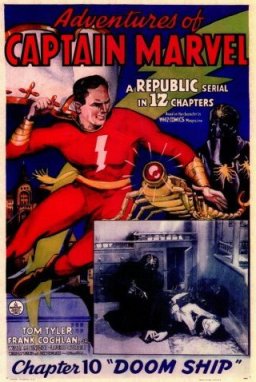
Adventures of Captain Marvel is a 1941 American 12-chapter black-and-white movie serial from Republic Pictures, produced by Hiram S. Brown, Jr., directed by John English and William Witney, that stars Tom Tyler in the title role of Captain Marvel and Frank Coghlan, Jr. as his alter ego, Billy Batson. The serial was adapted from the popular Captain Marvel comic book character, then appearing in the Fawcett Comics publications Whiz Comics and Captain Marvel Adventures. The character is now owned by DC Comics and is known as Shazam.

Zombies of the Stratosphere is a 1952 colorless Republic Studios serial directed by Fred C. Brannon, with a screenplay by Ronald Davidson, and special effects by Republic's Lydecker brothers. It was intended to be Republic's second serial featuring "new hero" Commando Cody and the third 12-chapter serial featuring the rocket-powered flying jacket and helmet introduced in King of the Rocket Men (1949). Instead, for reasons unknown, the hero was renamed "Larry Martin", who must prevent Martian invaders from using a hydrogen bomb to blow Earth out of its orbit, so that the Martians can move a dying Mars into a much closer orbital position to the Sun. As in Radar Men from the Moon, much of the screen time for each of the dozen chapters is spent on fistfights and car chases between the heroes and a gang of earthly crooks hired by renegade scientist Dr. Harding and his extraterrestrial colleague Marex to steal and stockpile the Atomic supplies needed for construction of the H-bomb.
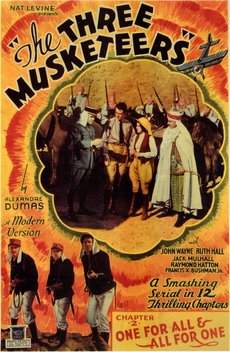
The Three Musketeers is a 1933 American pre-Code film serial directed by Armand Schaeffer and Colbert Clark, and produced by Nat Levine for Mascot Pictures. The film serial was very loosely based on Alexandre Dumas' 1844 novel The Three Musketeers, with the musketeers changed into three soldiers in the French Foreign Legion, and d'Artagnan being reconfigured as Lt. Tom Wayne, a pilot in the United States military.

Mysterious Doctor Satan is a 1940 American film serial directed by William Witney and John English. Produced by Republic Pictures, the serial stars Edward Ciannelli, Robert Wilcox, William Newell, C. Montague Shaw, Ella Neal, and Dorothy Herbert. The title of the serial is derived from that of its chief villain.

Drums of Fu Manchu (1940) is a 15-chapter Republic serial film based on the character created by Sax Rohmer. Though using the title of the ninth novel in the series, it actually is based on numerous elements from throughout the series to that point, cherry-picked by the writers. It starred Henry Brandon, William Royle and Robert Kellard. It was directed by the successful serial team constituee by William Witney and John English and is often considered one of the best serial films ever made.

The Fighting Devil Dogs (1938) is a 12-chapter Republic movie serial starring Lee Powell and Herman Brix, the latter better known by his later stage name, Bruce Bennett. It was directed by William Witney and John English. While not often considered a great serial, as it contains much stock footage and two recap chapters, it is famous for its main villain, the Lightning—the first costumed supervillain. There is some speculation that George Lucas used the Lightning as a template for Darth Vader.
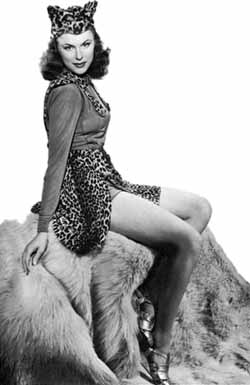
The Tiger Woman (1944) is a 12-chapter film serial by Republic Pictures starring Allan Lane and Linda Stirling. The serial was re-released in 1951 under the title Perils of the Darkest Jungle and, in 1966, it was edited into the 100-minute Century-66 film Jungle Gold.

King of the Royal Mounted (1940) is a Republic Pictures northern serial based on the King of the Royal Mounted comic strip directed by William Witney and John English.
The Vigilantes Are Coming is a 1936 American Republic film serial directed by Ray Taylor and Mack V. Wright. It was the third of the sixty six serials made by Republic Pictures.
The Lone Ranger Rides Again is a 1939 American Republic serial. It was a sequel to Republic's 1938 serial The Lone Ranger, which had been highly successful, and the thirteenth of the sixty-six serials produced by Republic.
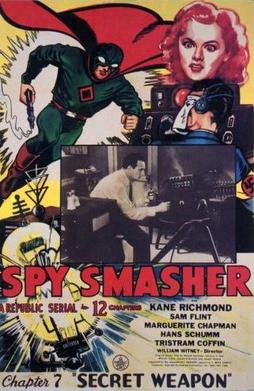
Spy Smasher is a 12-episode 1942 Republic serial film based on the Fawcett Comics character Spy Smasher which is now a part of DC Comics. It was the 25th of the 66 serials produced by Republic. The serial was directed by William Witney with Kane Richmond and Marguerite Chapman as the leads. The serial was Chapman's big break into a career in film and television. Spy Smasher is a very highly regarded serial. In 1966, a television film was made from the serial footage under the title Spy Smasher Returns.
Perils of Nyoka is a 1942 Republic serial directed by William Witney. It stars Kay Aldridge as Nyoka the Jungle Girl, a character who first appeared in the Edgar Rice Burroughs-inspired serial Jungle Girl.
King of the Mounties is a 1942 Republic 12-chapter film serial, directed by William Witney. Allan Lane played Sgt. Dave King of the Mounties, with Peggy Drake as heroine Carol Brent, and Abner Biberman played the villainous Japanese admiral Yamata.

Flying Disc Man from Mars is a 1950 Republic Pictures 12-chapter black-and-white science fiction adventure film serial, produced by Franklin Adreon, directed by Fred C. Brannon, that stars Walter Reed, Lois Collier, Gregory Gaye, James Craven, Harry Lauter, and Richard Irving. Disc Man is considered a weak example of the serial medium, even compared to other post-World War II serials. In 1958 Republic edited the serial's 167 minutes of footage into a 75-minute feature, released under the new title Missile Monsters.

Captain America is a 1944 Republic black-and-white 15-chapter serial film loosely based on the Timely Comics character Captain America. It was the last Republic serial made about a superhero. It also has the distinction of being the most expensive serial that Republic ever made. It stands as the first theatrical release connected to a Marvel character; the next theatrical release featuring a Marvel hero would not occur for more than 40 years. It was the last live-action rendition of a Marvel character in any medium until Spider-Man appeared in the Spidey Super Stories segment of the children's television series The Electric Company in 1974.

Mystery Mountain is a 1934 American Western serial film directed by Otto Brower and B. Reeves Eason and starring Ken Maynard, Verna Hillie, Syd Saylor, Edward Earle, and Hooper Atchley. Distributed by Mascot Pictures, Mystery Mountain features the second ever film appearance by Gene Autry.
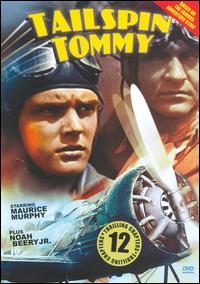
Tailspin Tommy is a 12-episode 1934 Universal film serial based on the Tailspin Tommy comic strip by Hal Forrest. Directed by Lew Landers and produced by Milton Gatzert, the serial was the 97th serial of the 137 released by that studio. The plot of Tailspin Tommy concerns a conflict over a government airmail contract.

Bruce Gentry – Daredevil of the Skies (1949) is a 15-episode Columbia Pictures movie serial based on the Bruce Gentry comic strip created by Ray Bailey. It features the first cinematic appearance of a flying saucer, as the secret weapon of the villainous Recorder.
References
Notes
- ↑ David Sharpe doubled Robert Wilcox, playing the Copperhead when in costume. [4]
Citations
- 1 2 3 4 Mathis 1995, pp. 50–51.
- ↑ Weiss and Goodgold 1973, pp. 171–172.
- ↑ Harmon and Glut 1973, p. 355.
- 1 2 3 Harmon and Glut 1973, pp. 357–358.
- ↑ Mysterious Doctor Satan VHS, cover box notes, Republic Home Entertainment, 1985.
- ↑ Goldweber, David Elroy. Claws & Saucers: Science Fiction, Horror, and Fantasy Film, A Complete Guide: 1902-1982. Oaklnad, California: David E. Goldweber, 2012.
- ↑ Blake, Jerry. 'Mysterious Doctor Satan'". The Files of Jerry Blake, September 19, 2013. Retrieved: June 7, 2016.
- 1 2 Stedman 1971, pp. 125, 141.
- ↑ Witney 2005.
- ↑ Hayes 2000, p. 54.
- ↑ Cline "3. The Six Faces of Adventure" 1984, p. 48.
- ↑ Cline 7. Masters of Menace (The Villains)" 1984, p. 117.
- ↑ Hardwick and Schnepf 1983, p. 56.
Bibliography
- Cline, William C. "In Search of Ammunition". In the Nick of Time. New York: McFarland & Company, Inc., 1984. ISBN 0-7864-0471-X.
- Harmon, Jim and Donald F. Glut. "Real Life Heroes: Just Strangle the Lion in Your Usual Way". The Great Movie Serials: Their Sound and Fury. New York: Routledge Publishing, 1973. ISBN 978-0-7130-0097-9.
- Hardwick, Jack and Ed Schnepf. "A Viewer's Guide to Aviation Movies". The Making of the Great Aviation Films, General Aviation Series, Volume 2, 1989.
- Hayes, R. M. The Republic Chapterplays: A Complete Filmography of the Serials Released by Republic Pictures Corporation, 1934-1955. Jefferson, North Carolina: McFarland & Company, Inc., 2000. ISBN 978-0-7864-0934-1.
- Mathis, Jack. Valley of the Cliffhangers Supplement. Barrington, Illinois: Jack Mathis Advertising, 1995. ISBN 0-9632878-1-8.
- Stedman, Raymond William. "5. Shazam and Good-by". Serials: Suspense and Drama By Installment. Norman, Oklahoma: University of Oklahoma Press, 1971. ISBN 978-0-8061-0927-5.
- Weiss, Ken and Ed Goodgold. To be Continued ...: A Complete Guide to Motion Picture Serials. New York: Bonanza Books, 1973. ISBN 0-517-166259.
- Witney, William. In a Door, Into a Fight, Out a Door, Into a Chase: Moviemaking Remembered by the Guy at the Door. Jefferson, North Carolina: McFarland & Company, Inc., 2005. ISBN 978-0-7864-2258-6.